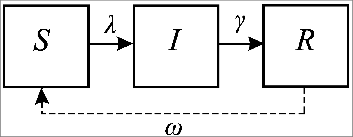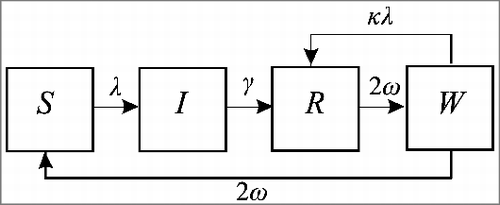Figures & data
Figure 1. The classic SIR epidemiologic model for infections inducing permanent immunity (solid lines). Susceptibles acquire infection and move to the I state at a rate λ, with the population in I losing infectiousness at a rate γ. The dashed line represents the SIRS variant, for infections inducing only temporary immunity, with immunity lost at a rate ω.

Figure 2. An SIRS model variant for infections with different characteristics for naïve and repeat infections. Naïve susceptibles (S1) acquire infection and move to the I1 state at a rate λ, with the population in I1 losing infectiousness at a rate γ and moving to the R compartment. Immunity is lost at a rate ω, after which individuals become susceptible to repeat infections (S2). This model structure assumes no return to the naïve state.

Figure 3. The boosting SIRWS model. Naïve susceptibles (S) acquire infection and move to the I state at a rate λ, with the population in I losing infectiousness at a rate γ and moving to the R compartment. Immunity is lost at a rate 2 ω, after which individuals can have their immunity boosted at a rate, κλ, proportional to the force of infection, without experiencing a transmissible infection (W). If not exposed, individuals in W return to the naïve susceptible state at a rate 2 ω.

